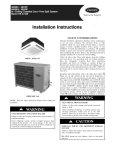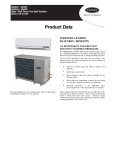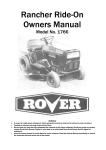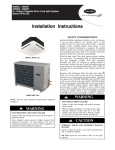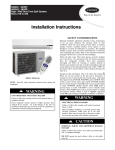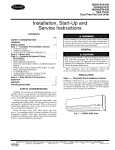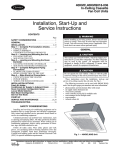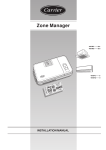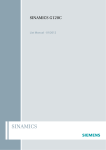Download Carrier 38QRF018-036 Instruction manual
Transcript
38QRF018---036
Duct Free Heat Pumps
Installation Instructions
SAFETY CONSIDERATIONS
Improper installation, adjustment, alteration, service, maintenance,
or use can cause explosion, fire, electrical shock, or other
conditions which may cause death, personal injury, or property
damage. Consult a qualified installer, service agency, or your
distributor or branch for information or assistance. The qualified
installer or agency must use factory--authorized kits or accessories
when modifying this product. Refer to the individual instructions
packaged with the kits or accessories when installing.
Follow all safety codes. Wear safety glasses, protective clothing,
and work gloves. Use quenching cloth for brazing operations.
Have fire extinguisher available. Read these instructions
thoroughly and follow all warnings or cautions included in
literature and attached to the unit. Consult local building codes and
National Electrical Code (NEC) for special requirements.
A07532
Fig. 1 -- 38QRF
NOTE: Read the entire instruction manual before starting the
installation.
TABLE OF CONTENTS
PAGE
SAFETY CONSIDERATIONS . . . . . . . . . . . . . . . . . . . . . . . . 1
INSTALLATION . . . . . . . . . . . . . . . . . . . . . . . . . . . . . . . . . 2--6
Complete Pre--Installation Checks . . . . . . . . . . . . . . . . . . . 2
Recognize safety information. This is the safety--alert symbol !!
When you see this symbol on the unit and in instructions or
manuals, be alert to the potential for personal injury. Understand
these signal words; DANGER, WARNING, and CAUTION. These
words are used with the safety--alert symbol. DANGER identifies
the most serious hazards which will result in severe personal injury
or death. WARNING signifies hazards which could result in
personal injury or death. CAUTION is used to identify unsafe
practices which would result in minor personal injury or product
and property damage. NOTE is used to highlight suggestions
which will result in enhanced installation, reliability, or operation.
!
WARNING
Rig and Mount Unit . . . . . . . . . . . . . . . . . . . . . . . . . . . . . . 5
ELECTRICAL SHOCK HAZARD
Complete Refrigerant Piping Connections . . . . . . . . . . . . . 5
Failure to follow this warning could result in personal
injury or death.
Make Electrical Connections . . . . . . . . . . . . . . . . . . . . . . . . 6
START--UP . . . . . . . . . . . . . . . . . . . . . . . . . . . . . . . . . . . . . . . . 9
SERVICE . . . . . . . . . . . . . . . . . . . . . . . . . . . . . . . . . . . . . . . . . 9
MAINTENANCE . . . . . . . . . . . . . . . . . . . . . . . . . . . . . . . . . . 13
TROUBLESHOOTING . . . . . . . . . . . . . . . . . . . . . . . . . . 14--15
Before installing, modifying, or servicing system, main
electrical disconnect switch must be in the OFF
position. There may be more than 1 disconnect switch.
Lock out and tag switch with a suitable warning label.
INSTALLATION
!
Inspect Shipment
File a claim with the shipping company if shipment is damaged or
incomplete. Check the unit nameplates to ensure units match job
requirements.
WARNING
Consider System Requirements
UNIT OPERATION AND SAFETY HAZARD
Failure to follow this warning could result in personal injury
or equipment damage.
Puron refrigerant systems operate at higher pressures than
standard R--22 systems.
Do not use R--22 service
equipment or components on Puron refrigerant equipment.
!
CAUTION
38QRF
PERSONAL INJURY AND EQUIPMENT DAMAGE
HAZARD
Failure to follow this caution may result in personal injury
and / or equipment damage.
DO NOT operate the unit without a filter or with grille
removed.
Complete Pre--Installation Checks
Unpack Unit
Move the unit to final location. Remove unit from carton,
being careful not to damage service valves and grilles.
Consult local building codes and NEC for special installation
requirements.
Allow sufficient space for airflow clearance, wiring, refrigerant
piping, and servicing unit. See Fig. 3.
Locate unit so that condenser airflow is unrestricted on both sides.
Refer to Fig. 3.
Unit may be mounted on a level pad directly on base legs or
mounted on raised pads at support points. See Fig. 3 for center of
gravity.
Matching the Heat Pump to an Indoor Unit
The 38QRF018--036 unit can be matched with either a 40QNQ
hi--wall unit or 40KMQ in--ceiling cassette unit. The 38QRF035
unit can only be matched with in--ceiling cassette indoor units. The
38QRF036 unit can only be matched with high wall indoor units.
Refer to separate indoor unit literature for more information
Check AccuRater Metering Device - Heating Mode
The correct AccuRater (bypass type) refrigerant control is required
for system capacity optimization. An AccuRater device with
field--replaceable piston is supplied with the outdoor unit (see Fig.
2). Select the correct piston for the application from Table 1
(heating & cooling).
NOTE: Arrow on AccuRater body points in free flow direction, away from the
indoor coil.
A07884a
*
*NOTE: Piston Orientation - Install tapered end
of piston in the direction of the outdoor equipment
for proper heating operation
A07407b
Fig. 2 -- AccuRater (bypass type) Metering Device Components
2
Fig. 3 -- 38QRF Unit Dimensions
A07883
3
CHASSIS
SIZE
(Reference)
0
0.6
1.0
018
024
030,035,036
1 -29/16
(369.9)
1 -29/16
(369.9)
1 -51/16
(433.4)
3 -015/16
(938.2)
3 -015/16
(938.2)
3 -89/16
(1131.9)
2 -11/8
(638.2)
2 -71/8
(790.6)
3 -13/16
(944.6)
C
B
A
NOTE: Dimensions shown in feet-inches. Dimensions in ( ) are millimeters.
38QRF
Unit Size
UNIT MODELS
1 -67/16
(468.3)
1 -4
(406.4)
1 -4
(406.4)
D
2 -61/2
(774.7)
1 -117/16
(595.3)
1 -117/16
(595.3)
E
1 -75/8
(498.5)
1 -53/16
(436.6)
1 -53/16
(436.6)
F
2 -53/16
(741)
1 -111/8
(587.4)
1 -51/8
(435)
G
1 -111/16
(347.7)
1 -2
(355.6)
1 -1
(330.2)
J
0 -81/8
(206.4)
0 -63/4
(171.5)
0 -65/8
(168.3)
K
1 -37/8
(403.2)
0 -115/8
(295.3)
0 -111/4
(285.8)
L
(FIELD PROVIDED AND INSTALLED)
2 -101/16
(865.5)
2 -4
(711.5)
1 -10
(559.1)
H
P
4
19.05
19.05
19.05
232
221
187
176
166
1 -11 x 3 -6
2 -0 x 4 -2
584.2 x 1066.8
609.6 x 1270
105.2
100.2
84.8
79.8
75.3
OPERATING WT
lb
(kg)
MINIMUM MOUNTING PAD
DIMENSIONS
Support Feet
ft-in.
mm
3/
4
3/
035
036
4
3/
030
15.88
15.88
8
8
5/
5/
CHASSIS SIZES 0 & .6
CHASSIS SIZES 1 & 1.6
UNIT SIZE
38QRF
HEAT
PUMPS
(mm)
M
in.
024
018
UNIT SIZE
3. Center of Gravity
.
NOTES:
1. Required clearances: with coil facing wall, allow 6 in. minimum clearance
on coil side and coil end, and 3 feet minimum clearance on compressor
end and fan side. With fan facing wall, allow 8 in. minimum clearance on
fan side and coil end, and 3 feet minimum clearance on compressor end
and coil side. With multi-unit application, arrange units so discharge of one
does not enter inlet of another.
2. Dimensions in parenthesis are in millimeters.
0 -61/2
(165.4)
0 -6
(152.4)
0 -6
(152.4)
38QRF
0 -37/16
(88)
0 -215/16
(75)
0 -215/16
(75)
N
38QRF
Table 1 – 38QRF018--036 Physical Data
UNIT 38QRF
NOMINAL CAPACITY Tons
OPERATING WEIGHT lb (kg)
REFRIGERANT TYPE
BASE UNIT CHARGE lb (kg)
ADDITIONAL CHARGE-- CASSETTE
lb (kg)
ADDITIONAL CHARGE-- HI -- WALL
lb (kg)
METERING DEVICE
High Wall Cooling
High Wall Heating
In --- Ceiling Cassette --- Cooling
In --- Ceiling Cassette --- Heating
COMPRESSOR
Type
Oil Charge (POE --- oz)
Crankcase Heater (watts)
OUTDOOR FAN
Rpm/Cfm
Diameter (in.)
No. Blades
Motor (hp)
OUTDOOR COIL
Face Area (sq ft)
No. Rows
FPI
HIGH PRESSURE SWITCH
Cut --- In (psig) Cutout (psig)
LOW PRESSURE SWITCH
Low Cutout (psig)
Low Cut --- in (psig)
REFRIGERANT LINES
Connection Type
Suction/Vapor (in.) OD
Mixed Phase* (in.) OD
Max Length ft (m)
Max Lift ft (m)
Max Drop ft (m)
CONTROLS
Control Voltage{
System Electrical
018
1.5
166 (75.3)
024
2.0
176 (79.8)
5.5 (2.49)
6.8 (3.08)
0.0 (0.0)
0.0 (0.0)
0.8 (0.36)
0.5 (0.23)
49
45
51
46
030
2.5
187 (84.8)
Puronr (R --- 410A)
10.7 (4.85)
035
2.9
221 (100.2)
036
3.0
232 (105.2)
10.5 (4.76)
10.0 (4.54)
1.8 (1.04)
0.0 (0.0)
--- ---
0.0 (0.0)
--- ---
0.0 (0.0)
--- ---
70
63
Accurater
63
53
63
55
55
49
55
53
70
63
Scroll
25.0
25.0
40
40
Propeller Type, Direct Drive, Horizontal
840/1720
850/3900
850/3900
18
24
24
3
3
3
1/8
1/4
1/4
25.0
—
25.0
—
840/1720
18
3
1/8
42.0
—
850/3900
24
3
1/4
5.8
2
20
7.3
3
20
12.1
2
20
12.1
2
20
12.1
2
20
420 ± 25
650 ± 10
420 ± 25
650 ± 10
420 ± 25
650 ± 10
420 ± 25
650 ± 10
420 ± 25
650 ± 10
20 ± 5
45 ± 25
20 ± 5
45 ± 25
20 ± 5
45 ± 25
20 ± 5
45 ± 25
20 ± 5
45 ± 25
5/8
Mixed Phase --- Flare / Suction --- Sweat
3/4
3/8
200 (60.96)
65 (19.81)
150 (45.72)
24 vac
208/230--- 1--- 60
208/230--- 1--- 60
FUSIBLE PLUG _F (_C)
FINISH
208/230--- 1--- 60
210 (98.89)
Gray
* Mixed phase line must be insulated.
{ 24 v and a minimum of 40 va is provided in the fan coil unit.
FPI --- Fins Per Inch
POE --- Polyol Ester
4
208/230--- 1--- 60,
208/230--- 3--- 60
460--- 3--- 60
208/230--- 1--- 60,
208/230--- 3--- 60
460--- 3--- 60
COMPLETE REFRIGERANT PIPING
CONNECTIONS
Mounting on Ground
Mount unit on a solid, level concrete pad. Position unit so water or
ice from roof does not fall directly onto unit. Accessory stacking
kits can be used when units are to be stacked. See installation
instructions provided with the accessory kit. Use field--provided
snow stand or ice rack where prolonged subfreezing temperatures
or heavy snow occurs.
If conditions or local codes require unit be fastened to a pad, 6
field--supplied tiedown bolts should be used and fastened through
slots provided in unit mounting feet.
For hurricane tie downs -- contact your local distributor for details
and PE (Professional Certification), if required by local authorities.
Outdoor units may be connected to indoor units using
field--supplied tubing of refrigerant grade and condition. See Table
1 for correct line sizes. Do not use less than 10 ft (3.05 m) of
interconnecting tubing.
!
UNIT DAMAGE HAZARD
Failure to follow this caution may result in equipment
damage or improper operation.
If any section of pipe is buried, there must be a 6 in. (152.4
mm) vertical rise to the valve connections on the outdoor
unit. If more than the recommended length is buried,
refrigerant may migrate to cooler, buried section during
extended periods of system shutdown. This causes
refrigerant slugging and could possibly damage the
compressor at start--up.
Mounting on Roof
Mount unit on a level platform or frame at least 6 in. (152.4 mm)
above roof surface. Isolate unit and tubing from structure.
Rigging
!
CAUTION
PERSONAL
INJURY
DAMAGE HAZARD
AND/OR
EQUIPMENT
Failure to follow this caution may result in personal injury
and/or equipment damage.
Be sure unit panels are securely in place prior to rigging.
Keep the unit upright and lift unit using a sling. Use cardboard or
padding under the sling, and spreader bars to prevent sling damage
to the unit. See Fig. 4. See Fig. 3 for center of gravity reference.
Install the unit so that the coil does not face into prevailing winds.
If this is not possible and constant winds above 25 mph are
expected, use accessory wind baffle. See installation instructions
provided with the accessory kit.
NOTE: Accessory wind baffles should be used on all units with
accessory low ambient temperature control.
Field--fabricated snow or ice stands may be used to raise unit when
operation will be required during winter months. Units may also be
wall mounted using the accessory wall mounting kit.
CAUTION
When more than 80 ft (24.4 m) of interconnecting tubing is used,
consult the Duct--Free Split System Long Line Application Guide
for required accessories. If either refrigerant tubing or indoor coil
is exposed to the atmosphere, the system must be evacuated
following good refrigeration practices.
Run refrigerant tubes as directly as possible. Insulate both tubes,
avoiding unnecessary turns and bends. Suspend refrigerant tubes to
avoid damage to insulation or tubes so that they do not transmit
vibration to structure. Also, when passing refrigerant tubes through
a wall, seal the opening so rain or insects do not enter structure.
Leave some slack in refrigerant tubes between structure and
outdoor unit to absorb vibration. Refer to separate indoor unit
installation instructions for additional information.
Filter Drier
Refer to Fig. 2 and install filter drier as follows:
1. Assemble all parts as shown in Fig. 2
2. The filter drier must be replaced whenever the refrigeration
system is exposed to the atmosphere.
3. Only use factory specified liquid--line filter driers with rated
working pressures less than 600 psig.
NOTE: Do not install a suction--line filter drier in liquid line.
A07396
Fig. 4 -- Lifting Unit with Sling
5
38QRF
RIG AND MOUNT UNIT
Make Suction Tube Sweat Connection
Remove plastic caps from liquid and suction service valves. Use
refrigerant grade tubing. Service valves are closed from the factory
and are ready for brazing. After wrapping the service valve with a
wet cloth, the tubing set can be brazed to the service valve using
either silver bearing or non--silver bearing brazing material.
Consult local code requirements. Refrigerant tubing and the indoor
coil are now ready for leak testing.
NOTE: Unit is shipped with Puronr refrigerant factory charge
indicated on nameplate.
Pass nitrogen or other inert gas through piping while brazing to
prevent formation of copper oxide.
!
switch open (off) is advisable to prevent power from being turned
on while unit is being serviced.
Disconnect switch, fuses, and field wiring must comply with the
NEC and local code requirements. Use copper wire only between
the disconnect switch and unit. Use minimum 60_C wire for the
field power connection.
Route power wires through the opening in unit side panel and
connect in the unit control box as shown on the unit label diagram
and Fig. 7. Unit must be grounded.
GROUND LEAD
SINGLE-PHASE
CONN TO
DISCONNECT
PER NEC
CAUTION
GROUNDING LUG
BLK
BLK
SINGLE-PHASE UNIT
UNIT DAMAGE HAZARD
38QRF
Failure to follow this caution may result in equipment damage
or improper operation.
BLK
To prevent damage to unit or service valves observe the
following:
S Use a brazing shield.
S Wrap service valves with wet cloth or use a heat sink
material.
THREE-PHASE UNIT
MAKE ELECTRICAL CONNECTIONS
ELECTRICAL SHOCK HAZARD
Failure to follow this warning could result in personal injury or
death.
The unit cabinet must have an uninterrupted or unbroken
ground to minimize personal injury if an electrical fault should
occur. The ground may consist of electrical wire or metal
conduit when installed in accordance with existing electrical
codes.
!
CAUTION
UNIT DAMAGE HAZARD
Failure to follow this caution may result in equipment damage
or improper operation.
Unit failure as a result of operation on improper line voltage or
excessive phase imbalance constitutes abuse and may cause
damage to electrical components. Such operation could void
any applicable Carrier warranty.
!
GROUNDING LUG
LEGEND
NEC -- National Electrical Code
-- Splice (field)
Field Wiring
Factory Wiring
A fusible plug is located in unit suction line; do not cap this plug.
If local code requires additional safety devices, install as directed.
WARNING
YEL
GROUND LEAD
Provide Safety Relief
!
BLU
THREE-PHASE
CONN TO
DISCONNECT
PER NEC
A08251
Fig. 5 -- Line Power Connections
Control Circuit Wiring
Control voltage is 24 v (40 va minimum). See Fig. 6 and Fig. 7
and unit label diagram for field--supplied wiring details. Route
control wire through opening in unit side panel to connection in
unit control box.
NOTE:
Use No. 18 AWG color--coded, insulated (35_C
minimum) wire. If thermostat is located more than 100 ft. from
unit, as measured along the control voltage wires, use No. 16 AWG
color--coded wire to avoid excessive voltage drop.
NOTE: All wiring must conform to NEC and local codes.
NOTE: Operating unit on improper line voltage constitutes abuse
and could affect Carrier warranty. See Table 2. Do not install unit
in a system where voltage may fluctuate above or below
permissible limits.
See Table 2 for recommended fuse sizes. When making electrical
connections, provide clearance at the unit for refrigerant piping
connections.
NOTE: The 38QRF units use the control transformer supplied
with the matched indoor unit.
WARNING
ELECTRICAL SHOCK HAZARD
Failure to follow this warning could result in personal injury or
death.
Before performing service or maintenance, be sure indoor unit
main power switch is turned OFF and indoor blower has
stopped.
Power Wiring
Unit is factory wired for voltage shown on nameplate. Provide
adequate, fused disconnect switch within sight from unit, readily
accessible, but out of reach of children. Provision for locking the
A08237
Fig. 6 -- 38QRF Typical Control Circuit Connections
6
Fig. 7 -- 38QRF018--060 Typical Wiring Schematic
A08238
7
—
—
—
—
—
—
—
—
—
—
—
—
—
—
—
—
TH
TRAN
LEGEND
Contactor, Compressor
Capacitor
Crankcase Heater Thermostat
Crankcase Heater
Compressor Motor
Defrost Thermostat
Equipment
Ground
High-Pressure Switch
Liquid Low Pressure Switch
Outdoor Air Temperature
Outdoor Fan Motor
Outdoor Fan Relay
Overload
Reversing Valve Solenoid
Terminal Board
Factory Wiring
Field Control Wiring
Field Power Wiring
Splice
Terminal Block
Terminal (Unmarked)
Terminal (Marked)
Splice (Field)
— Thermistor
— Transformer
NOTE: All thermistors are identical.
THERMISTOR EQUIVALENCE
Temperature
Resistance
F
C
95
35
6,500
72
22
11,400
32
0
32,500
NOTES:
1. Compressor and fan motors are thermally protected.
2. Wire in accordance with National Electrical Code (NEC) and local codes. Replace any
original wires with 90° C wire or its equivalent.
3. Use minimum 60° C wire for field power wiring.
4. Transformer factory wired for 230 v. For 208 v move blue wire to 208 volt tap.
5. Crankcase heater and thermostat used on selected models only.
C
CAP
CCHT
CH
COMP
DFT
EQUIP
GND
HPS
LLPS
ODA
OFM
OFR
OL
RVS
TB
38QRF SCHEMATIC
38QRF OPERATION SEQUENCE
38QRF
CALL FOR COOLING:
1. Control voltage from transformer to microprocessor control in indoor unit (24 v).
2. At microprocessor control 24 v is switched to “G,” “O,” and “Y.”
3. 24 v from microprocessor control “G” energizes fan relay at outdoor unit and outdoor-fan motor
runs.
4. 24 v from microprocessor control “O” energizes RVS at outdoor unit through “O” on outdoor unit
terminal board.
5. 24 v from the microprocessor control “Y” energizes the contactor coil in the outdoor unit. The compressor will run.
6. If the HPS, internal protector of the compressor, or LLPS open, the 24 v to the contactor will be
interrupted. The compressor and outdoor fan motor will stop.
CALL FOR HEATING:
1. Control voltage from transformer to microprocessor control in indoor unit (24 v).
2. At microprocessor control 24 v is switched to “G,” “Y,” and “R.”
3. 24 v from microprocessor control “G” energizes fan relay at outdoor unit and outdoor fan motor
runs.
4. 24 v from microprocessor control “Y” energizes the contactor coil and the compressor will run.
5. Demand defrost is controlled by the indoor unit microprocessor control.
6. The indoor unit microprocessor control continuously monitors both outdoor coil temperature and
outdoor ambient temperature, determining the optimum defrost length and interval for existing outdoor conditions.
DEFROST MODE:
1. Microprocessor control switches 24 v to “O” and energizes RVS.
2. Microprocessor control switches 24 v from outdoor fan relay, deenergized relay stops outdoor fan
motor operation.
3. Microprocessor control will terminate defrost when outdoor coil sensor reaches 64.4 F or after
10 minutes of defrost operation. Unit then switches back to normal heating mode.
4. During heating or defrost, if the HPS, internal protector of the compressor, or LLPS open, the 24 v
to the contactor coil will be interrupted, the compressor and outdoor fan motor will stop.
Table 2 – 38QRF Electrical Data
38QRF
UNIT
SIZE
018
024
030
035
036
VOLTAGE RANGE*
V--- PH --- Hz
208/230 ---1 ---60
208/230 ---1 ---60
208/230 ---1 ---60
208/230 ---1 ---60
208/230 ---3 ---60
460 ---3 ---60
208/230 ---1 ---60
208/230 ---3 ---60
460 ---3 ---60
COMPRESSOR
Min
Max
RLA
LRA
FLA
NEC Hp
kW Out
MIN CKT
AMPS
187
187
187
187
187
414
187
187
414
253
253
253
253
253
506
253
253
506
9.0
12.8
14.1
16.7
10.4
5.8
17.9
13.2
6.0
48.0
58.3
73.0
79.0
79.0
79.0
112.0
88.0
44.0
0.80
0.80
1.50
1.50
1.50
0.80
1.45
1.45
0.80
0.125
0.125
0.25
0.25
0.25
0.25
0.25
0.25
0.25
0.09
0.09
0.19
0.19
0.19
0.19
0.19
0.19
0.19
12.1
16.8
18.4
22.3
14.5
8.7
23.8
18.0
8.3
38QRF
LEGEND:
FLA --- Full Load Amps
LRA --- Locked Rotor Amps
NEC --- National Electrical Code
RLA --- Rated Load Amps (compressor)
* Permissible limits of the voltage range at which the unit will operate
satisfactorily
NOTES:
1. Control circuit is 24 ---V on all units and requires external power
source. Copper wire must be used from service disconnect to unit.
2. All motors/compressors contain internal overload protection.
3. In compliance with NEC (U.S.A. Standard) requirements for multimotor and combination load equipment (refer to NEC Articles 430
and 440), the overcurrent protective device for the unit shall be fuse.
4. Motor RLA values are established in accordance with UL (Underwriters’ Laboratories) Standard 465 (U.S.A. Standard).
5. 38QRF018 ---030 units are only available in single ---phase voltage.
6. Unbalanced 3--- Phase Supply Voltage
Never operate a motor where a phase imbalance in supply voltage is
greater than 2%. Use the following formula to determine the percentage of voltage imbalance:
= 100 X
OUTDOOR FAN MOTOR
Determine maximum deviation from average voltage:
(AB) 457 ---452 = 5v
(BC) 464 ---457 = 7v
(AC) 457 ---455 = 2v
Maximum deviation is 7v.
Determine percentage of voltage imbalance
% of voltage imbalance = 100 x
= 1.53%
IMPORTANT: Contact your local electric utility company immediately if the
supply voltage phase imbalance is more than 2%.
EXAMPLE: Supply voltage is 460 ---3 ---60
AB = 452v
BC = 464v
AC = 455v
=
=
7
57
This amount of phase imbalance is satisfactory as it is below the maximum
allowable of 2%.
max voltage deviation from average voltage
average
Average Voltage =
FUSE/
HACR
BKR
AMPS
20
25
30
35
20
15
40
30
15
452 + 464 + 455
3
1371
3
457
8
Preliminary Checks
1. Check that all internal wiring connections are tight and that
all barriers, covers, and panels are in place.
2. Field electrical power source must agree with unit nameplate rating.
3. All service valves must be open.
4. Belly--band crankcase heater must be tight on compressor
crankcase for those units with belly--band heaters.
Leak Test
Field piping and fan coil must be leak tested by pressure method.
Use Puronr refrigerant at approximately 25 psig backed up with an
inert gas to a total pressure not to exceed 245 psig.
NOTE: Leak detectors should be designed to detect HFC
(hydroflourocarbon) refrigerant.
Evacuate and Dehydrate
Field piping and fan coil must be evacuated and dehydrated.
Charge System
Release charge into system by opening (backseating) liquid and
suction line service valves.
Refrigerant Charging
!
NOTE: Unit is shipped with a minimum factory charge. For
different fan coils, see Charge Adjustment in Table 1. For line
length beyond 80 ft. (24.4 m), see the Duct Free Split Systems
Long Line Guide.
To Start Unit
WARNING
PERSONAL INJURY
DAMAGE HAZARD
S Manifold sets should be 700 psig high side and 180 psig low
side with 550 psig low--side retard.
S Use hoses with 700 psig service pressure rating.
S Puron refrigerant, as with other HFCs, is only compatible with
POE oils.
S Vacuum pumps will not remove moisture from oil.
S Polyol Ester oils absorb moisture rapidly. Do not expose oil to
atmosphere.
S Polyol Ester oils may cause damage to certain plastics and
roofing materials.
S Wrap all filter driers and service valves with wet cloth when
brazing.
S Factory approved, liquid--line filter drier is required on every
unit.
S If using a suction line drier, do not leave in place for more than
72 hours.
AND/OR
EQUIPMENT
Failure to follow this warning could result in personal
injury and/or equipment damage.
Be sure that the field disconnect is closed. Set room thermostat
below ambient temperature. Operate unit for 15 minutes, then
check system refrigerant charge. See Refrigerant Charging section.
NOTE: When using in conjunction with 40QA fan coils, refer to
start--up instructions included with fan coil for correct start--up
procedures.
SERVICE
Wear safety glasses and gloves when handling
refrigerant. Do not overcharge system -- this can cause
compressor flooding.
!
ELECTRICAL SHOCK HAZARD
WARNING
PERSONAL INJURY
DAMAGE HAZARD
AND/OR
Failure to follow this warning could result in personal
injury or death.
EQUIPMENT
Before installing, modifying, or servicing system, main
electrical disconnect switch must be in the OFF
position. There may be more than 1 disconnect switch.
Lock out and tag switch with a suitable warning label.
Failure to follow this warning could result in personal
injury and/or equipment damage.
Service valves must be fully backseated to close service
port. There is no Schrader valve at the service port, and
failure to backseat the valve could result in loss of
system charge or personal injury.
NOTE:
Do not vent or de--pressurize unit refrigerant to
atmosphere. Remove and recover refrigerant following accepted
practices.
All units are shipped with the refrigerant charge listed on the
nameplate.
The recommended procedure for charging is the “weigh--in”
method. If using the subcooling method, use 12_ for the desired
subcooling temperature.
Refer to Table 1 and consider the following when working with
Puronr refrigerant:
S Puron refrigerant cylinders are rose colored.
S Recovery cylinder service pressure rating must be 400 psig,
DOT (Department of Transportation) 4BA400 or DOT BW400.
S Puron systems should be charged with liquid refrigerant. Use a
commercial type metering device in the manifold hose when
charging into suction line with compressor operating.
WARNING
!
Outdoor Fan
A reinforced wire mount holds the outdoor fan assembly in
position. See Fig. 8 for proper mounting position.
38QRF Unit Size, in. (mm)
018,024
030,035,036
0.433 (11.00)
0
A07401
Fig. 8 -- Condenser Fan Mounting Positions
High-- Pressure Relief Valve
The high--pressure relief valve is located in the compressor. The
relief valve opens at a pressure differential of approximately 550 to
9
38QRF
START--UP
625 ± 50 psig between suction (low side) and discharge (high side)
to allow pressure equalization.
Internal Current and Temperature Sensitive Overload
The crankcase heater is powered by the high--voltage power of the
unit. It is connected across the line side of the contactor and is
thermostatically controlled.
The control resets automatically when internal compressor motor
temperature drops to a safe level (overloads may require up to 45
minutes to reset). When an internal overload is suspected of being
open, check by using an ohmmeter or continuity tester.
!
PERSONAL INJURY HAZARD
Failure to follow this warning could result in personal
injury or death.
Pumpdown Procedure
The system may be pumped down in order to make repairs on the
low side without losing complete refrigerant charge.
!
CAUTION
UNIT DAMAGE HAZARD
38QRF
Failure to follow this caution may result in equipment
damage or improper operation.
Never open system to atmosphere while it is under a
vacuum.
When system must be opened for service, recover refrigerant, break
vacuum with dry nitrogen before opening system.
1. Attach pressure gage to suction service valve gage port.
2. Frontseat the mixed--phase line valve.
!
CAUTION
UNIT DAMAGE HAZARD
Failure to follow this caution may result in equipment
damage or improper operation.
The unit coils hold only the factorydesignated amount of
refrigerant. Additional refrigerant may cause units to relieve
pressure through the compressor internal pressure relief
valve (indicated by a sudden rise of suction pressure) before
suction pressure reaches 20 psig. If this occurs, shut off unit
immediately then frontseat the suction valve and remove
and recover excess refrigerant following accepted practices
3. Start unit and run until suction pressure reaches 20 psig.
4. Shut unit off and frontseat suction valve.
5. De--pressurize low side of unit and recover refrigerant following accepted practices.
High-- Pressure Switch
The high--pressure switch, located on discharge line, protects
against high discharge pressures caused by such events as
overcharge, condenser--fan motor failure, system restriction, etc. It
opens on pressure rise at about 650 ± 10 psig. If system pressures
go above this setting during abnormal conditions, the switch
opens.
!
WARNING
WARNING
Use extreme caution when troubleshooting this device as
line voltage is continually present.
To troubleshoot:
1. Apply voltmeter across crankcase heater leads to see if heater voltage is on. Do not touch heater. Carefully feel area
around crankcase heater; if warm, crankcase heater is functioning.
2. With power off and heater leads disconnected, check across
leads with ohmmeter. Do not look for a specific resistance
reading. Check for resistance or an open circuit, and change
heater if an open circuit is detected.
Service Valves
The service valves in the outdoor unit come from the factory
frontseated. This means the refrigerant charge is isolated from the
line--set connection ports. To prevent damage to the valve, use a
wet cloth or other accepted heat sink material on the valve before
brazing.
The service valve cannot be field repaired, therefore, only a
complete valve or valve stem seal and service port caps are
available for replacement.
Defrost Controls
The defrost process is controlled by a defrost thermostat switch, an
accumulated compressor run timer and an adaptively optimized
defrost interval.
The accumulated compressor run timer keeps running when the
defrost thermostat switch is closed and the compressor is running
in heating mode. When the compressor turns off, the timer stops
running but retains its current value. If the compressor turns on
later, the timer will resume running from its retained value. When
the defrost thermostat switch is open, the accumulated compressor
run timer resets to zero.
When the accumulated compressor timer reaches the defrost
interval, defrost process is initiated. When in defrost, if the defrost
thermostat switch becomes open, the defrost process will terminate.
If the defrost time has reached 10 minutes and the defrost
thermostat switch is still closed, the defrost process will terminate.
If the defrost process lasts more than 3 minutes, the defrost interval
will increase by 5 minutes. If the defrost process lasts more than 7
minutes, the defrost interval will decrease by 5 minutes. The
allowed range for defrost interval is 30 -- 90 minutes. When a unit
is powered up, the defrost interval takes the default value of 90
minutes.
PERSONAL INJURY HAZARD
Failure to follow this warning could result in personal injury
or death.
DO NOT attempt to simulate these system abnormalities -high pressures pose a serious safety hazard.
The high--pressure switch is checked with an ohmmeter. If system
pressure is below 625 psig switch shows continuity.
Crankcase Heater
The crankcase heater prevents refrigerant migration and
compressor oil dilution during shutdown when compressor is not
operating. If the crankcase heater is de--energized for more than 6
hours, both compressor service valves must be closed.
10
Reversing Valve
38QRF
In heat pumps, changeover between heating and cooling modes is
accomplished with a valve that reverses flow of refrigerant in the
system. The reversing valve solenoid can be checked with the
power off using an ohmmeter. Check for continuity and shorting to
ground. With control circuit (24 v) power on, check for correct
voltage at solenoid coil, and for burned or overheated solenoid.
With unit operating, other items can be checked, such as frost or
condensate on refrigerant lines.
Using a remote measuring device, check inlet and outlet line
temperatures. Do not touch lines. If reversing valve is operating
normally, inlet and outlet temperatures on appropriate lines should
be similar. Any temperature difference would be due to heat loss or
gain across valve body. Temperatures are best checked with a
remote reading electronic--type thermometer with multiple probes.
Figures 9 and 10 show test points on reversing valve for recording
temperatures. Insulate points for more accurate reading. If valve is
defective:
1. Shut off all power to unit.
2. Remove all charge from system.
3. Remove valve using a tubing cutter.
4. Install new valve (wrap valve with a wet rag to prevent
overheating while brazing).
5. After valve is brazed in, check for leaks.
6. Evacuate and charge system. Operate system in both modes
several times to be sure valve functions properly.
LEGEND
TP — Test Point
LEGEND
TP — Test Point
A07433
A07434
Fig. 9 -- Reversing Valve
(Cooling Mode or Defrost Mode, Solenoid Energized)
Fig. 10 -- Reversing Valve
(Heating Mode, Solenoid De--energized)
11
12
PRESSURE
PSIG
12
14
16
18
20
22
24
26
28
30
32
34
36
38
40
42
44
46
48
50
52
54
56
58
60
62
64
66
68
70
72
74
76
78
80
82
84
86
88
90
92
94
96
98
100
102
104
106
108
110
112
TEMPERATURE
°F
°C
–37.7
--- 38.72
–34.7
--- 37.06
–32.0
--- 35.56
–29.4
--- 34.11
–26.9
--- 32.72
–24.5
--- 31.90
–22.2
--- 30.11
–20.0
--- 28.89
–17.9
--- 27.72
–15.8
--- 26.61
–13.8
--- 25.44
–11.9
--- 24.39
–10.1
--- 23.39
–8.3
--- 22.39
–6.5
--- 21.39
–4.5
--- 20.28
–3.2
--- 19.56
–1.6
--- 18.67
0.0
--- 17.78
1.5
--- 16.94
3.0
--- 16.11
4.5
--- 15.28
5.9
--- 14.50
7.3
--- 13.72
8.6
--- 13.00
10.0
--- 12.22
11.3
--- 11.50
12.6
--- 10.78
13.8
--- 10.11
15.1
--- 9.39
16.3
--- 8.72
17.5
--- 8.06
18.7
--- 7.39
19.8
--- 6.78
21.0
--- 6.11
22.1
--- 5.50
23.2
--- 4.89
24.3
--- 4.28
25.4
--- 3.67
26.4
--- 3.11
27.4
--- 2.56
28.5
--- 1.94
29.5
--- 1.39
30.5
--- 0.83
31.2
--- 0.44
32.2
0.11
33.2
0.67
34.1
1.17
35.1
1.72
35.5
1.94
36.9
2.72
PRESSURE
PSIG
114
116
118
120
122
124
126
128
130
132
134
136
138
140
142
144
146
148
150
152
154
156
158
160
162
164
166
168
170
172
174
176
178
180
182
184
186
188
190
192
194
196
198
200
202
204
206
208
210
212
214
TEMPERATURE
°F
°C
37.8
3.22
38.7
3.72
39.5
4.17
40.5
4.72
41.3
5.17
42.2
5.67
43.0
6.11
43.8
6.56
44.7
7.06
45.5
7.50
46.3
7.94
47.1
8.39
47.9
8.83
48.7
9.28
49.5
9.72
50.3
10.17
51.1
10.61
51.8
11.00
52.5
11.39
53.3
11.83
54.0
12.22
54.8
12.67
55.5
13.06
56.2
13.44
57.0
13.89
57.7
14.28
58.4
14.67
59.0
15.00
59.8
15.44
60.5
15.83
61.1
16.17
61.8
16.56
62.5
16.94
63.1
17.28
63.8
17.67
64.5
18.06
65.1
18.39
65.8
18.78
66.4
19.11
67.0
19.44
67.7
19.83
68.3
20.17
68.9
20.50
69.5
20.83
70.1
21.17
70.7
21.50
71.4
21.89
72.0
22.22
72.6
22.56
73.2
22.89
73.8
23.22
PRESSURE
PSIG
216
218
220
222
224
226
228
230
232
234
236
238
240
242
244
246
248
250
252
254
256
258
260
262
264
266
268
270
272
274
276
278
280
282
284
286
288
290
292
294
296
298
300
302
304
306
308
310
312
314
316
TEMPERATURE
°F
°C
74.3
23.50
74.9
23.83
75.5
24.17
76.1
24.50
76.7
24.83
77.2
25.11
77.8
25.44
78.4
25.78
78.9
26.06
79.5
26.39
80.0
26.67
80.6
27.00
81.1
27.28
81.6
27.56
82.2
27.89
82.7
28.17
83.3
28.50
83.8
28.78
84.3
29.06
84.8
29.33
85.4
29.67
85.9
29.94
86.4
30.22
86.9
30.50
87.4
30.78
87.9
31.06
88.4
31.33
88.9
31.61
89.4
31.89
89.9
32.17
90.4
32.44
90.9
32.72
91.4
33.00
91.9
33.28
92.4
33.56
92.8
33.78
93.3
34.06
93.8
34.33
94.3
34.61
94.8
34.89
95.2
35.11
95.7
35.39
96.2
35.67
96.6
35.89
97.1
36.17
97.5
36.39
98.0
36.67
98.4
36.89
98.9
37.17
99.3
37.39
99.7
37.61
PRESSURE
PSIG
318
320
322
324
326
328
330
332
334
336
338
340
342
344
346
348
350
352
354
356
358
360
362
364
366
368
370
372
374
376
378
380
382
384
386
388
390
392
394
396
398
400
402
404
406
408
410
412
414
416
418
TEMPERATURE
°F
°C
100.2
37.89
100.7
38.17
101.1
38.39
101.6
38.67
102.0
38.89
102.4
39.11
102.9
39.39
103.3
39.61
103.7
39.83
104.2
40.11
104.6
40.33
105.1
40.61
105.4
40.78
105.8
41.00
106.3
41.28
106.6
41.44
107.1
41.72
107.5
41.94
107.9
42.17
108.3
42.39
108.8
42.67
109.2
42.89
109.6
43.11
110.0
43.33
110.4
43.56
110.8
43.78
111.2
44.00
111.6
44.22
112.0
44.44
112.4
44.67
112.6
44.78
113.1
45.06
113.5
45.28
113.9
45.50
114.3
45.72
114.7
45.94
115.0
46.11
115.5
46.39
115.8
46.56
116.2
46.78
116.6
47.00
117.0
47.22
117.3
47.39
117.7
47.61
118.1
47.83
118.5
48.06
118.8
48.22
119.2
48.44
119.6
48.67
119.9
48.83
120.3
49.06
PRESSURE
PSIG
420
422
424
426
428
430
432
434
436
438
440
442
444
446
448
450
452
454
456
458
460
462
464
466
468
470
472
474
476
478
480
482
484
486
488
490
492
494
496
498
500
502
504
506
508
510
512
514
516
518
520
Table 3 – Pressure vs. Temperature Chart -- Puron (R--410A) Refrigerant
38QRF
TEMPERATURE
°F
°C
120.7
49.28
121.0
49.44
121.4
49.67
121.7
49.83
122.1
50.06
122.5
50.28
122.8
50.44
123.2
50.67
123.5
50.83
123.9
51.06
124.2
51.22
124.6
51.44
124.9
51.61
125.3
51.83
125.6
52.00
126.0
52.22
126.3
52.39
126.6
52.56
127.0
52.78
127.3
52.94
127.7
53.17
128.0
53.33
128.3
53.50
128.7
53.72
129.0
53.89
129.3
54.06
129.7
54.28
130.0
54.44
130.3
54.61
130.7
54.83
131.0
55.00
131.3
55.17
131.6
55.33
132.0
55.56
132.3
55.72
132.6
55.89
132.9
56.06
133.3
56.28
133.6
56.44
133.9
56.61
134.0
56.67
134.5
56.94
134.8
57.11
135.2
57.33
135.5
57.50
135.8
57.67
136.1
57.83
136.4
58.00
136.7
58.17
137.0
58.33
137.3
58.50
PRESSURE
PSIG
522
524
526
528
530
532
534
536
538
540
544
548
552
556
560
564
568
572
576
580
584
588
592
596
600
604
608
612
616
620
624
628
632
636
640
644
648
652
656
660
664
668
672
676
680
684
688
692
696
TEMPERATURE
°F
°C
137.6
58.67
137.9
58.83
138.3
59.06
138.6
59.22
138.9
59.39
139.2
59.56
139.5
59.72
139.8
59.89
140.1
60.06
140.4
60.22
141.0
60.56
141.6
60.89
142.1
61.17
142.7
61.50
143.3
61.83
143.9
62.17
144.5
62.50
145.0
62.78
145.6
63.11
146.2
63.44
146.7
63.72
147.3
64.06
147.9
64.39
148.4
64.67
149.0
65.00
149.5
65.28
150.1
65.61
150.6
65.89
151.2
66.22
151.7
66.50
152.3
66.83
152.8
67.11
153.4
67.44
153.9
67.72
154.5
68.06
155.0
68.33
155.5
68.61
156.1
68.94
156.6
69.22
157.1
69.50
157.7
69.83
158.2
70.11
158.7
70.39
159.2
70.67
159.8
71.00
160.3
71.28
160.8
71.56
161.3
71.83
161.8
72.11
MAINTENANCE
!
WARNING
ELECTRICAL SHOCK HAZARD
Failure to follow this warning could result in personal
injury or death.
Before installing, modifying, or servicing system, main
electrical disconnect switch must be in the OFF
position. There may be more than 1 disconnect switch.
Lock out and tag switch with a suitable warning label.
LUBRICATION
Compressor
Compressor contains factory oil charge; replace oil when lost. Use
Mobile 3MA--POE oil.
CLEANING COILS
Coil should be washed out with water or blown out with
compressor air. Note that the blow--thru design causes dirt and
debris to build up on the inside of the coils. Clean coil annually or
as required by location and outdoor air conditions. Inspect coil
monthly and clean as required. Fins are not continuous through
coil sections. Dirt and debris may pass through first section,
become trapped between the row of fins and restrict condenser
airflow. Use a flashlight to determine if dirt or debris has collected
between coil sections. Clean coil as follows:
1. Turn off unit power.
2. Using a garden hose or other suitable equipment, flush coil
from the outside to remove dirt. Be sure to flush all dirt and
debris from drain holes in base of unit. Fan motors are waterproof.
13
TROUBLESHOOTING
LEGEND
NC
— Normally Closed
ODT — Outdoor Thermostat
NOTE: For systems with indoor units equipped with microprocessor
control, see separate controls, service, and troubleshooting manual.
A07435
Fig. 11 -- Troubleshooting the Cooling Cycle
14
TROUBLESHOOTING (CONT.)
LEGEND
NC
— Normally Closed
ODT — Outdoor Thermostat
NOTE: For systems with indoor units equipped with microprocessor
control, see separate controls, service, and troubleshooting manual.
A07436
Fig. 12 -- Troubleshooting the Heating Cycle
15
Copyright 2010 Carrier Corp. S 7310 W. Morris St. S Indianapolis, IN 46231
Printed in U.S.A.
Edition Date: 10/10
Manufacturer reserves the right to change, at any time, specifications and designs without notice and without obligations.
16
Catalog No:38QRF---5SI
Replaces: 38QR--- 4SI
















